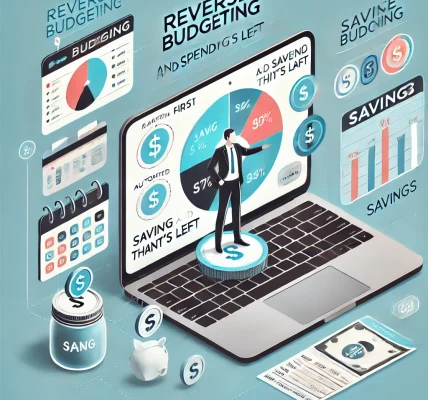Freelancers and entrepreneurs often enjoy flexibility and independence, but managing irregular income can be a challenge. Unlike traditional employees with predictable paychecks, your income may fluctuate month-to-month, making it difficult to budget and plan for future expenses.
Without a clear strategy, irregular income can lead to financial stress, missed investment opportunities, and cash flow issues. This guide will help you build a robust budgeting system tailored to the unique challenges faced by freelancers and entrepreneurs.
Why Budgeting Is Essential for Irregular Income
A solid budgeting plan helps you:
- Stabilize Cash Flow: Manage your finances during high and low-income months.
- Achieve Financial Goals: Stay on track with savings, investments, and long-term objectives.
- Reduce Stress: Gain peace of mind knowing you’re prepared for financial uncertainties.
- Optimize Spending: Make intentional spending decisions without compromising your financial future.
By establishing a comprehensive budgeting system, you can maintain financial stability despite unpredictable earnings.
Step 1: Understand Your Income Patterns
The first step to effective budgeting is understanding how your income flows throughout the year. Start by analyzing your earnings from the past 12 months.
- Track Your Income: Record every payment received from clients or business activities.
- Identify Patterns: Are there seasonal highs and lows? Recognize months when you earn more or less.
- Calculate Your Average Income: Add up the total income for the past year and divide it by 12 to estimate your monthly average.
This data helps you forecast future earnings and plan your budget accordingly.
Step 2: Separate Business and Personal Finances
Mixing personal and business finances complicates budgeting and tax management. Establish clear boundaries by:
- Opening Separate Bank Accounts: Use distinct accounts for business income and personal expenses.
- Paying Yourself a Salary: Transfer a consistent amount from your business account to your personal account monthly.
- Tracking Business Expenses: Monitor and categorize business-related costs for better tax deductions and accurate budgeting.
Maintaining separate accounts also simplifies financial tracking and prevents overspending.
Step 3: Establish a Baseline Budget
Your baseline budget covers essential expenses that must be paid regardless of income fluctuations. Identify your fixed and variable costs:
- Fixed Expenses: These remain consistent each month (e.g., rent, insurance, loan payments).
- Variable Expenses: These fluctuate based on usage (e.g., utilities, groceries, entertainment).
Calculate the minimum amount required to cover these essential expenses monthly.
Step 4: Build an Emergency Fund
An emergency fund acts as a financial buffer during low-income months or unexpected expenses. For freelancers and entrepreneurs, aim to save 6-12 months’ worth of essential expenses.
- Start Small: Allocate a percentage of each payment to your emergency fund.
- Automate Savings: Use automatic transfers to consistently grow your emergency cushion.
- Use High-Yield Accounts: Store emergency funds in high-interest savings accounts for better returns.
An adequately funded emergency reserve provides security and stability during income fluctuations.
Step 5: Adopt the 60/20/20 Budgeting Method
The 60/20/20 method works well for irregular income earners by dividing each payment into three categories:
- 60% – Needs: Fixed and variable expenses (housing, utilities, food).
- 20% – Savings & Investments: Emergency fund, retirement accounts, and other investments.
- 20% – Discretionary Spending: Entertainment, dining, travel, and other non-essential expenses.
During higher-income months, prioritize savings and investments to prepare for leaner times.
Step 6: Smooth Out Income Volatility
To create financial consistency, implement strategies to stabilize your cash flow:
- Pay Yourself a Set Salary: Base your monthly “salary” on your average earnings.
- Create an Income Buffer: Keep a reserve to draw from during low-income periods.
- Diversify Income Streams: Expand your services, launch digital products, or pursue passive income sources.
These tactics help you maintain a steady cash flow despite irregular payments.
Step 7: Plan for Taxes Year-Round
Freelancers and entrepreneurs must manage their own tax obligations. Avoid tax-related surprises by:
- Estimate Tax Liability: Calculate your expected tax rate based on annual income.
- Set Aside Taxes: Save a portion of each payment (e.g., 25-30%) for tax obligations.
- Quarterly Tax Payments: Submit estimated taxes quarterly to avoid penalties.
Consult a tax professional for guidance on deductions, credits, and accurate tax planning.
Step 8: Adjust Your Budget Regularly
Since irregular income fluctuates, review and update your budget regularly:
- Monthly Check-Ins: Compare actual income and expenses to your budget.
- Quarterly Adjustments: Reassess income patterns and modify your salary if necessary.
- Annual Reviews: Evaluate long-term goals and adjust your budgeting strategy as your business grows.
Regular reviews help you stay adaptable and responsive to income changes.
Step 9: Utilize Budgeting Tools
Leverage technology to simplify financial management:
- Budgeting Apps: Use platforms like YNAB (You Need A Budget) or Mint to track income and expenses.
- Expense Trackers: Categorize and monitor spending with digital tools.
- Invoice Software: Streamline client payments and income tracking.
Automation reduces manual effort and enhances budgeting accuracy.
Step 10: Prioritize Long-Term Financial Goals
Despite irregular income, you can achieve long-term financial stability by:
- Investing Consistently: Contribute to retirement accounts and brokerage portfolios during high-income months.
- Planning for Retirement: Open and fund tax-advantaged accounts like IRAs or solo 401(k)s.
- Setting Milestones: Define specific financial goals (e.g., homeownership, debt-free living) and align your budget accordingly.
Stay disciplined and adaptable to achieve lasting financial freedom.
Conclusion
Budgeting for irregular income requires strategic planning, disciplined execution, and regular reviews. By understanding your income patterns, maintaining separate finances, and building an emergency fund, you can create a resilient financial system.
Adopt budgeting techniques like the 60/20/20 method, prioritize tax planning, and leverage technology to simplify financial management. With consistent effort, you can maintain financial stability, grow your investments, and achieve long-term success as a freelancer or entrepreneur.



